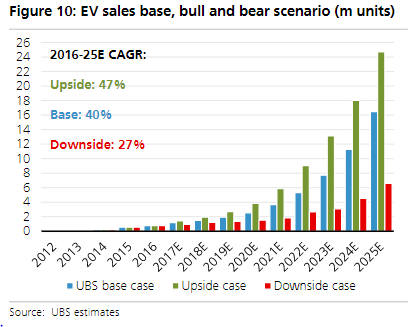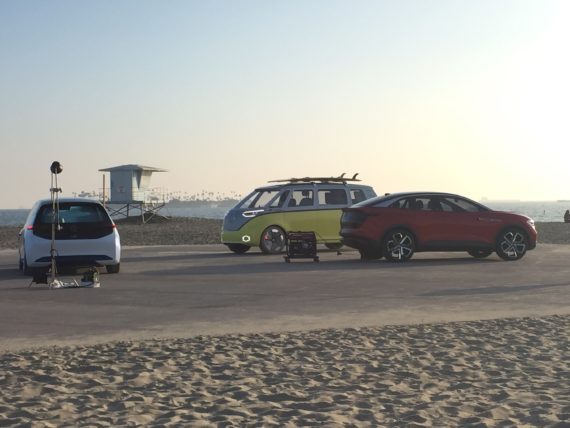There was quite a lot that we missed in the climate and clean energy world this week. So, in an effort to catch up, we’re going to provide you with a handful of the major highlights. But before we continue, I’d like to also mention that a major and potentially weather event with climate change related influences is now starting to slam the U.S. Northeast with high winds, waves and heavy surf.
We’re compiling a report for later this afternoon on yet one more extreme weather event in a long procession. So watch this space.
The Amazon Rainforest is on the brink of collapse. For a number of years now, we’ve been covering the dual impacts of human-caused climate change and deforestation on the Amazon Rainforest. One of our expert commenters, Umbrios, is a Brazil native and regularly provides updates in the threads below. So those who’ve followed along here have known for a while now that the Amazon is in serious trouble.
Rising temperatures are increasing instances of wildfires within the typically wet forest. Meanwhile, encroaching farms and settlements have cut and burned through the lush jungle, invading it with roads and threatening to choke off what is one of the great ecological treasures of our world.
(A combination of slash and burn deforestation, droughts, rising temperatures and wildfires are pushing the Amazon Rainforest to the brink. A new study finds that human encroachment and climate change are on the verge of transforming half of the Amazon into less productive grasslands. Image source: The Union of Concerned Scientists.)
The concern is that the Amazon, which is under increasing threat like so many other key environments around the world, reaches a tipping point where much of it is transformed into less productive and less helpful Savannah. Where that point rests on the temporal and spatial scale has long been a subject of debate. But a new study finds that it’s much closer than many had feared.
In total, about 17 percent of the Amazon has been deforested. And what the study found was that, due to continued rising temperatures associated with human caused climate change, only another 3 percent deforestation would be enough to transform fully half of the Amazon into Savannah. In this case, global warming is acting in concert with local clear-cutting to provide a dual threat to this great forest that is home to 14 million species and is one of the largest remaining carbon sinks on the planet.
Tesla competitors emerge. On the sustainability side of our ongoing story of tragedy, hope and crisis, we find that a number of automakers are emerging to challenge Tesla’s all-renewable business model. Unfortunately, so far, most automakers are confronting Tesla with single model designs rather than a full transformation of business strategies. But what is encouraging is the rising quality of EVs entering the production fleet.
A good example is this week’s announcement by Jaguar that its I-PACE EV can out accelerate some versions of the Tesla Model X. I-PACE is an EV sporting a 90 KW battery pack and a 240 mile range. It’s priced between 87,000 and 102,000 dollars (US) and it has a stated acceleration of 4.5 seconds from 0-60 mph. This makes it a peer or a near peer to the Tesla Model X which starts at 85,000 dollars, has an all electric range of between 257 and 289 miles, and can accelerate from 0-60 in 4.9 to 2.9 seconds (P100D).
(Jaguar promotes smaller, long-range, high performance, high-price I-PACE electric vehicle as competitor to the Tesla Model X. But is Jaguar really serious about transformational EV production? Or is it just trying to slow Tesla’s all-renewable Juggernaut down? Image source: Jaguar.)
The I-PACE is, however, smaller than the X. Weighing less, it likely relies on this lower mass to match Model X acceleration and range due to Tesla’s superior battery energy density. But what is clear is that Jaguar is trying to compete with Tesla on turf that the all-electric automaker has long dominated.
Jaguar claims that the I-PACE is part of a transformational strategy. But a single EV entry is hardly tranformational compared to Tesla’s larger EV-only production chain and design path. So the question for renewable energy supporters is — does this Janguar really help to speed the clean energy transition, or is it just another rock a primarily fossil fuel based motor company is throwing into the road to delay Tesla? Time, and the number of EVs Jaguar produces (both as models and as single model production) will tell.
Scientists are concerned about the risk of civilization collapse due to climate change and how harmful political ideologies are making matters worse. So my background is one of emerging threats. I worked in the U.S. military, as a member of the U.S. Navy’s DOD force protection group, and as Editor for Emerging Threats at Jane’s Information Group. And it has long been my goal here to analyze climate change impacts in the frame of a systemic threat that increases civilization collapse pressure.
In the military context, climate change is often described as a Threat Multiplier. Rising global temperatures and associated sea level rise, growing season disruption, and increasingly severe weather events can severely damage infrastructure or tear at the fabric of societies — generating conditions of mass desperation the world over. Those focused both on humanitarian relief efforts, often a military mission, and on combating rising instances of extremism (which are often fueled by economic desperation or inability to access shelter, food, and water) are now very concerned about the impact of climate change disruptions on global stability.
(Illustration of instances where climate change has multiplied instability. Note that effects range well outside the regions indicated in the above graphic. Image source: Climate Change as a Problem of National and International Security.)
Unfortunately, these disruptions do not always occur far from home. And no nation has a viable defense against harms associated with climate change. Over the past year, the U.S. has seen some of the most damaging extreme weather events in its history. And most of these have been scientifically linked to climate change. One instance — Maria’s strike to Puerto Rico — resulted in a systemic collapse that has yet to be fully repaired. Part of this failure is due to the severe nature of the climate change enhanced storm. But another aspect of the U.S.’s failure to support Puerto Rico was the fact that the Republican Party was held in the grips of the harmful ideology of climate change denial, jingoism, and anti-government thinking.
This ideology, which has captured so much of the political state of play of one of the world’s greatest nations, cripples responses to the growing existential threat of climate change. It denies both mitigation in the form of renewable energy funding even as it denies the necessary level of support in response to the disasters that climate change produces in ever-greater numbers and on increasingly destructive scales.
The new climate change collapse threat study discussed above is being conducted to examine the societal risks of climate change in light of political capture by harmful ideologies that fail to recognize realities on the ground as they emerge. We’ll be following it here with interest.
Trump trashed on terrible, disjointed, reckless environmental policies. Pretty much every thinking, rational person in the free world has now been woke to the fact that Trump cares little for the safety and security of the American people and sees the office of the Presidency primarily as a means to advance the personal interests of himself, his family, and his close associates. Never before has an Administration acted in so corrupt a fashion or courted so many nefarious entities in a brazen effort at self-promotion, damn all public consequences.
“Over and over again, the Trump administration has put the profits of multinational polluters over the health and well-being of everyday Americans,” — Eric Schneiderman, New York’s attorney general.
One of Trump’s first harmful and self-serving actions was raise Scott Pruitt to head of the Environmental Protection Agency. An unprecedented assault of critical safety-related protections of the American citizenry soon followed. An assault led by policies promoted, through Pruitt, not just by his allies in the coal, oil, and gas industry; but by practically every harmful polluting industry.
(The Center For Biological Diversity has filed 57 lawsuits against the Trump Administration. And it just just one of many agencies leveling an all out response to Trump’s assault on the environment.)
The Trump Administration has tried to enable the dumping of dental mercury into water systems, to allow the use of a substance harmful to child brain development, to enable the environmental release of such dangerous toxins as lead, to let gas companies leak poisonous and climate change enhancing methane plumes into the local environment, to allow trucks and automobiles that spew smog, to halt the protection of key species like bumblebees, and to roll back the Clean Power Plan, the Clean Air Act, and the Clean Water Act.
Such harmful and irresponsible actions have resulted in the Administration being hit by scores of court cases. Rick Sniedermann, the New York Attorney General, alone has produced 50 environmental lawsuits aimed at preventing the roll-back of key protections. And in many instances, the Administration’s pro-polluter policies are suffering serious losses in court.
Utilities partner with EV manufacturers. There’s an amazing clean energy synergy that’s yet to be fully leveraged. It’s a case where wind, solar, other clean energy sources, EVs and EV batteries are capable both of reducing emissions and of creating valuable new energy markets. PG&E apparently recognizes this opportunity and is more than willing to partner with automakers to incentivize it.
BMW and PG&E are offering a 10,000 dollar rebate for the BMW i3 to utility customers. The offer is beneficial to those purchasing an EV because it can reduce the cost of a 44,000 dollar EV to 24,000 after all state, federal, and utility/automaker rebates.
(PG&E power mix shows potential for substantial greenhouse gas emissions reductions for EV owners who purchase electricity from the utility vs those who own a gasoline or diesel-burning vehicle. At some point, PG&E may well considering changing its name to Pacific Electric. As the gas portion is increasingly less relevant to its energy portfolio. Image source: PG&E.)
The utility benefits due to increased electricity demand coming from the EV user. And BMW benefits from the marketing provided by PG&E which helps it to clear old models from its inventory and pave the way for more advanced electrical cars.
It’s also worth noting that PG&E generates more than 70 percent of its electricity from non-carbon-emitting sources and it has a goal for continuing to expand its clean energy allotment. So EV owners who are PG&E customers are engaged in substantially reducing their transportation based carbon emissions over time.




















